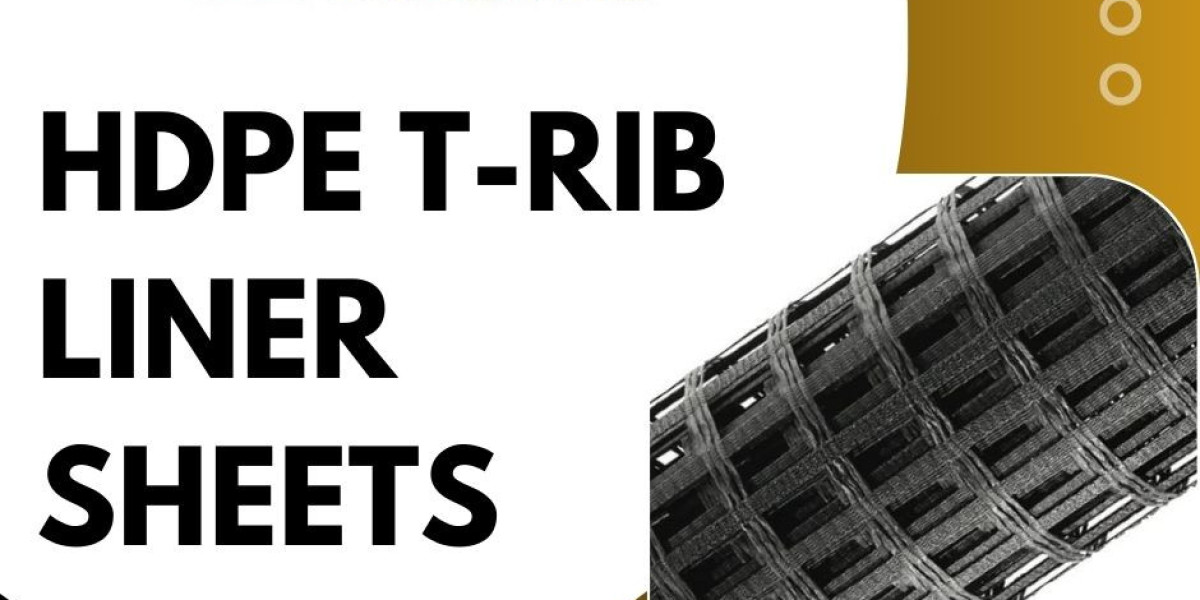In the relentless battle against wear, abrasion, and corrosion, industries across the globe are constantly seeking innovative solutions to protect their valuable equipment and infrastructure. High-Density Polyethylene (HDPE) T-Rib Liner Sheets have emerged as a game-changing technology, offering a superior combination of strength, durability, and cost-effectiveness. These specialized sheets, characterized by their unique T-shaped rib pattern, provide an unparalleled level of protection, making them the ultimate solution for long-lasting surface protection in a wide array of challenging environments. This article will delve into the intricacies of T-Rib HDPE liner sheets, exploring their advantages, diverse applications, installation methodologies, and the key players shaping the market, particularly within the context of the Indian industrial landscape.
Understanding T-Rib HDPE Liner Sheets: A Technological Marvel
T-Rib HDPE liner sheets are engineered from High-Density Polyethylene (HDPE), a thermoplastic polymer renowned for its exceptional strength-to-weight ratio, chemical resistance, and abrasion resistance. The distinctive feature of these sheets is the molded T-shaped rib pattern on their surface. This innovative design significantly enhances the liner's performance, offering a multitude of benefits:
Superior Impact Resistance: The T-ribs act as shock absorbers, distributing impact forces over a wider area and reducing the risk of cracking or damage to the underlying structure or materials. This is crucial in environments where materials are loaded or unloaded with significant force, such as in mining or construction.
Unmatched Abrasion Resistance: The increased surface area provided by the T-ribs, combined with HDPE's inherent abrasion resistance, creates an incredibly durable barrier against abrasive materials. This minimizes wear and tear, prolonging the lifespan of the liner and protecting valuable equipment from damage.
Enhanced Material Flow: The T-rib pattern can facilitate the smooth flow of materials, reducing friction and preventing clogging or bridging, especially in applications involving bulk materials like coal, ore, or grains. This improved flow increases efficiency and reduces downtime.
Exceptional Chemical Resistance: HDPE's resistance to a wide range of chemicals and corrosive substances makes T-Rib Liner Sheets ideal for challenging environments where exposure to acids, bases, solvents, and other harsh chemicals is a concern. This ensures the liner's integrity and prevents degradation.
High Tensile Strength and Load-Bearing Capacity: HDPE T-Rib Liner Sheets possess high tensile strength, enabling them to withstand substantial pressure and heavy loads without deforming.
Easy Installation: They are designed for straightforward installation, often using mechanical fasteners or welding techniques, which minimizes installation time and labor costs.
Cost-Effectiveness: While the initial investment might vary, HDPE T-Rib Liner Sheets often offer a more cost-effective solution compared to alternative protective methods over their entire lifespan, due to reduced maintenance, replacement, and downtime.
The synergistic combination of these attributes makes T-Rib HDPE liner sheets a versatile and highly effective solution for demanding applications. The sheets can be customized in terms of rib spacing, sheet thickness, and material formulation to suit specific requirements and optimize performance.
The Advantages: Why Choose T-Rib HDPE Liner Sheets?
The adoption of T-Rib HDPE liner sheets is driven by their distinct advantages over traditional liner materials and alternative protection methods:
Exceptional Durability and Longevity: The inherent strength and resilience of HDPE, coupled with the reinforcing effect of the T-rib design, provide exceptional durability and resistance to wear and tear. This translates into a significantly longer lifespan compared to other liner options, minimizing the need for frequent replacements and reducing downtime, resulting in significant cost savings.
High Resistance to Abrasion and Impact: The T-ribs and HDPE composition provide exceptional resistance to both abrasive forces and impact. This protects valuable equipment and infrastructure from damage, a critical benefit in industries like mining and material handling where such factors are constantly present.
Improved Material Handling Efficiency: The unique T-rib pattern facilitates the smoother flow of materials within chutes, hoppers, and conveyors. This minimizes friction, prevents material buildup, and reduces the risk of clogging or blockages, thereby increasing efficiency and minimizing operational expenses.
Superior Chemical Resistance: HDPE's resistance to a broad spectrum of chemicals and corrosive agents makes T-Rib Liner Sheets ideal for environments where exposure to hazardous chemicals is a major concern. This protects the liner and enhances its lifespan.
Reduced Noise and Vibration: HDPE's inherent properties help absorb noise and vibration, contributing to a safer and more comfortable working environment. This is of particular significance in industries with noisy machinery and vibrating processes.
Lower Maintenance Costs: The impressive durability and abrasion resistance of T-Rib HDPE Liner Sheets translate into reduced maintenance requirements. This minimizes downtime for repairs and replacements, leading to considerable cost savings over the long term.
Cost-Effectiveness Over Time: While the initial investment may be slightly higher than some alternatives, T-Rib HDPE Liner Sheets often prove to be a more cost-effective solution in the long run. The reduced maintenance, extended lifespan, and enhanced performance translate to significant savings over the lifetime of the application.
Customization and Versatility: T-Rib HDPE Liner Sheets can be tailored to the specific requirements of an application. Variations in rib spacing, sheet thickness, and material formulation allow for optimized performance based on the unique needs of the client.
Applications of T-Rib HDPE Liner Sheets: Protecting Critical Infrastructure
T-Rib HDPE Liner Sheets are utilized across a diverse range of industries where long-lasting surface protection is essential:
Mining: This is a primary application area. T-Rib HDPE Liner Sheets protect chutes, hoppers, truck beds, and other equipment that handles abrasive materials such as coal, ore, and aggregates. Their abrasion resistance is a critical factor in this challenging environment.
Material Handling: The sheets are used extensively in conveyor systems, storage bins, and loading docks to protect equipment and facilitate material flow.
Transportation: They are used to line truck beds and rail cars, providing vital protection during the transportation of abrasive materials, protecting the vehicle's structure from damage.
Agriculture: T-Rib HDPE Liner Sheets protect grain storage silos, feed bins, and other agricultural equipment from wear and tear, facilitating the flow of grains and other materials.
Waste Management: They are deployed to line waste containers and landfill cells, preventing damage and helping to contain waste materials safely and effectively.
Construction: The sheets are used to protect concrete mixers, asphalt plants, and other construction equipment, extending their operational lifespan.
Chemical Processing: Within the chemical processing industry, they provide protection against the corrosive effects of acids, bases, and solvents on equipment.
Bulk Storage: They also are used extensively in bulk storage facilities to safeguard storage containers and equipment from abrasion and impact, ensuring material integrity.
Installation of HDPE T-Rib Liner Sheets: Ensuring Optimal Performance
Proper installation is crucial to ensure the optimal performance and longevity of HDPE T-Rib liner sheets installation. The process typically involves these steps:
Surface Preparation: The surface to be lined must be thoroughly cleaned and prepared. Any sharp protrusions, debris, or unevenness should be removed to ensure a smooth and even surface.
Measurement and Cutting: Accurate measurements of the area to be lined are essential. The HDPE T-Rib Liner Sheets are then cut to the appropriate dimensions.
Positioning and Alignment: The sheets are carefully positioned and aligned, ensuring that the T-ribs are oriented in the correct direction to optimize material flow or impact resistance.
Fastening or Welding: The sheets are typically secured using mechanical fasteners (bolts, screws) or by welding the seams together. Welding creates a continuous, watertight seal and is often preferred for applications involving liquids or corrosive materials.
Sealing: Seams and any other penetrations are sealed carefully to prevent leaks and ensure the long-term integrity of the liner.
Inspection: A thorough inspection of the installed liner is essential to identify any potential issues. Any areas requiring further attention should be addressed immediately.
T-Rib HDPE Liner Sheets in India: Meeting the Growing Demand
The Indian market for T-Rib HDPE liner sheets India is experiencing significant growth, driven by increasing industrialization, infrastructure development, and a growing awareness of the benefits of these innovative protective solutions.
- Expansion of the Mining Sector: The mining sector is a significant consumer of T-Rib HDPE Liner Sheets, and its continued expansion is driving demand.
- Growth in Infrastructure Development: The construction of roads, bridges, and other infrastructure projects necessitates robust protective solutions, fueling the demand.
- Rising Awareness of Cost-Effectiveness: Businesses are increasingly recognizing the long-term cost savings associated with T-Rib HDPE Liner Sheets.
- Government Initiatives: Government initiatives promoting industrial growth and infrastructure development are further stimulating market expansion.
Key Players in the Market:
The market is served by both domestic and international manufacturers. Mahira Polyglobal LLP is a prominent player in the Indian market, providing high-quality T-Rib HDPE Liner Sheets and offering comprehensive support to its customers. Their focus on quality, innovation, and customer satisfaction has established them as a trusted partner for industries seeking reliable protective solutions.
Conclusion
The future of T-Rib HDPE Liner Sheets looks promising. Ongoing advancements in polymer science and manufacturing technologies are leading to the development of even more advanced and high-performing sheets. As industries continue to seek cost-effective and long-lasting solutions to protect their valuable assets, the demand for T-Rib HDPE Liner Sheets is poised to experience sustained growth. Companies like Mahira Polyglobal LLP that focus on innovation, quality, and customer service will be ideally positioned to capitalize on this growing market and provide the ultimate solutions for long-lasting surface protection.
Frequently Asked Questions (FAQs)
What are the primary advantages of T-Rib HDPE Liner Sheets?
Exceptional durability, high abrasion and impact resistance, improved material flow, chemical resistance, reduced maintenance costs, and cost-effectiveness are key advantages.What industries commonly use T-Rib HDPE Liner Sheets?
Mining, material handling, transportation, agriculture, waste management, construction, and chemical processing are all significant users.How are T-Rib HDPE Liner Sheets installed?
Installation methods include surface preparation, measurement, cutting, positioning, fastening or welding, and sealing.








